Where to site your woodfired oven
With spring finally starting to have sprung, lots of people are looking at buying woodfired ovens and one of the most important things to consider is where to site your woodfired oven. Here’s some of the advice we pass on to our students on our woodfired courses for making the most out of your site. It will take a little planning and working out what you’ve got but it’s definitely worth it in the long run.
1. Convenience. Site your woodfired oven as near to your kitchen as you can. We know you’ll have dreamt of having your your woodfired oven down at the bottom of the garden in that particularly sunny spot. Remember though that that seemingly perfect site will mean someone will be doing a lot of walking back to the main kitchen to get that pair of tongs or any other essential equipment that you’ve forgotten to take out with you. Unless you are creating an entire kitchen with refrigeration, running water and lots of storage (which some people do have), then it will really save your legs if you’re as close to the main kitchen as possible and your oven will get the regular use it deserves.
If you’ve got a mobile oven that you can store in the garage or in a shed, make sure it is within easy access of the storage and on a smooth path if at all possible.
If your home has limited access to the back garden or wherever you plan to site your woodfired oven, do make sure the oven will be able to get through that narrow pathway or through that gate. We have heard many many stories of ovens arriving kerbside, the lorry driver heading off having made his delivery and then the new owner realising that the oven just won’t fit. Usually a call to the local rugby club with promises of pizza in exchange for some muscle or a handy friend with a crane have made all things possible but not always.
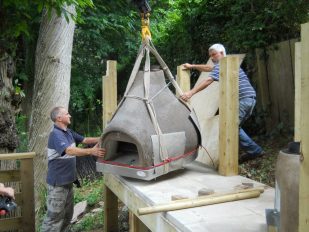
Our woodfired ovens arriving with the help of a crane
2. Cover. Seriously consider building a roof over the woodfired oven to protect both the oven and the cooks. Wouldn’t it be lovely to fire up the oven knowing that it will be dry and so will you? Well here in the UK that’s not ever entirely likely. Some covering over your oven will mean it is protected from the worst of the elements and won’t absorb as much damp from the driving rain as if it was uncovered. If your oven regularly gets wet it will absorb moisture and your fire will need to drive off that moisture before it can start cooking efficiently.
If you’re under cover, the oven is protected and your fire will be used for heating rather than drying out the oven. Obviously you’re protected too and more likely to use your oven on a regular basis, not just those 6 weekends a year you can guarantee perfect conditions. Otherwise, much like the Great British barbeque, the cook is out in the weather, protected by an umbrella, while the rest of the party is peering out from the house, wondering when the food will be ready and how damp it will be

A dry cook is a happy cook!
3. Neighbourliness. A well made oven, like our Bushmans, Morsos and Alfas, if they burn dry wood will work super efficiently, producing very little smoke. However, that doesn’t mean no smoke. All ovens when first lit and when wood is added will smoke for a while.
Do consider your neighbours and your own comfort by putting the oven where the smoke is least likely to drift into open windows. You might also consider putting a long flue on the oven to take the smoke to a height where no one will notice it. It’s worth inviting the neighbours round every now and then to enjoy some woodfired cooking and warning them when you’re likely to fire up, especially if their windows are open or their laundry is on the line.
4. Insulation. If you have an insulated oven, make sure it is well insulated both above and below. We’ve had so many students on our courses saying their ovens are losing heat too quickly and they can’t work out why; they’ve insulated the oven to keep in the rising heat but it still cools down too quickly.
Well let’s head back to secondary school physics for a moment; yes I was asleep at the back of the lab too but science suddenly becomes much more interesting when there’s food and cooking involved……Heat does rise in a fluid; but in a solid mass (ie your oven) it heads out in all directions and that means downward too so make sure your oven has a good bed of insulation to sit on before you put it in place.
5. Wind. Position the oven so the door is not facing into the prevailing wind. This means the food won’t get covered in ash flying around the oven and also that the fire won’t be fighting a draught whenever the door is open. The fire will burn hotter, be less disturbed and you’ll get to eat sooner and without a light dusting of embers.
6. Workspace. Build lots of workspace around the oven. In any kitchen you need more workspace than you think and your outdoor kitchen is no exception. If you haven’t got space for permanent surfaces, a couple of trestle tables will do the job but make sure they have heatproof surfaces for placing hot pans.
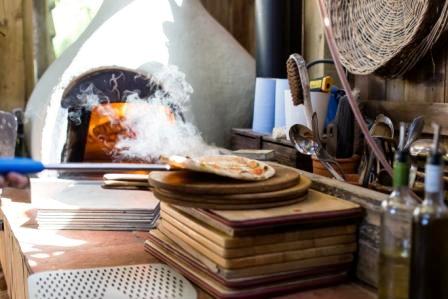
Plenty of work surface is very useful as with any kitchen
Additionally, set the oven back so there is a lip of 8–10 inches (but no more) in front of the door. This allows you to easily bring out a pan and give it a stir or turn over some meat. If you don’t have this you’ll always be looking for a space to put your pot on; wandering round with hot pans and liquids is never a good idea. It’s also worth screwing in some clips to the sides of your work surface so you can store your peels and other longhandled tools so they are within easy reach when you need them.
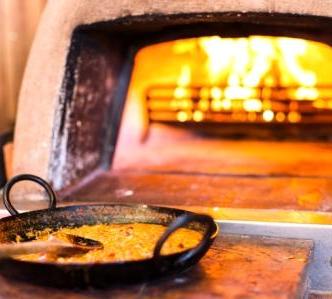
Handy to have space in front of your oven doors to slide out hot pans
7. Working Height. Set the door at a working height of not less than 1m to avoid too much bending. Make sure you always look after your back!
8. Storage. Allow lots (and lots) of space for log storage. We have plenty of space under the ovens for log storage; you need them close by so you can feed the fire when necessary without wandering off to refill your log carrier. We also have them stacked under seating and along walls. As with your oven, make sure your wood is under cover – you’ve gone to all the trouble of buying dry wood and then if you leave the logs out in the elements to be rained on, they are just going to absorb moisture and that’s going to affect your fires.
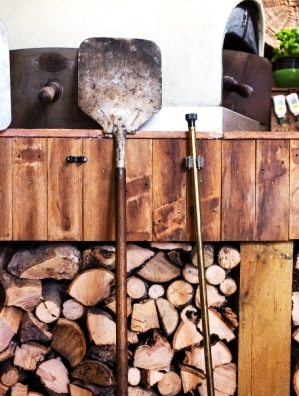
Plenty of undercover storage for wood and clamps/clips for peels and other long handled tools
So plenty to think about! Who would have thought where to site your woodfired oven would have so much going on…. However like most things it’s all in the planning and half an hour or so with a pencil and paper, taking measurements and drawing plans will be time well spent when you do finally get to cook with your new woodfired oven.
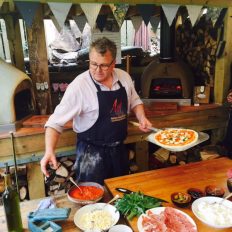
Finally cooking with your woodfired oven

